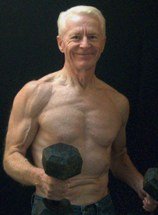| Back to Back Issues Page |
 |
|
The Gray Iron Fitness Newsletter, Issue #144 Balance your training. August 15, 2014 |
Hi
August 15, 2014
In this newsletter . . . Balance your trainingSome months ago, a subscriber, age 61, wrote that he has been doing four days per week of cardio and wants to incorporate resistance band exercise into his routine. He asked how he should go about it. There is more than one way. For example, he could do cardio and resistance training on alternating days. Or he could combine cardio with resistance work in single workouts by doing fast-paced circuit routines. Circuit routines require setting up exercise “stations,” where you do a resistance exercise and quickly move on to another different resistance exercise. The trick to doing affective circuit training is using enough resistance to tax your muscles while at the same time moving quickly enough between exercises to get your heart rate up. Sometimes jogging, running place, or doing calisthenics between exercise stations is a way of maintaining a target heart rate. Circuit training can be effective for all-around fitness. It is not as effective, however, for building maximum strength. For example, if your goal is to reach maximum strength potential, you must rest between sets of resistance training. Or if your goal is to run, cycle, or swim as fast or as long as your genetic potential allows, you must not stop in the middle of a run or swim to lift weights. You must separate the two types of training. But take a large random group of fitness trainees and you will probably find the majority is not training to become world-class competitors in a specific sport. Rather, most of them train for a fitness balance of strength and good cardiovascular health. Like most, I fall into this category. Most of the time, I like separating my cardio from resistance work. And there are two ways to do it: 1) At the same workout do resistance exercise first, and follow it with cardio; or 2) do cardio and resistance training on alternating days. I prefer alternating days for a couple of reasons. First, I do not like overly long workouts. Even when I was younger, devoting anything over an hour in the gym took the fun out of it. By alternating exercise days, I now spend 35 minutes on my resistance workout days and 35 minutes on cardio session days. The second reason I like alternating days is because the sessions are short enough that I can put more effort into each one. If I were to combine them, I would have to pace myself (devote less effort per exercise) in order to have sufficient energy to make it through lengthier workouts. Younger trainees may not have to concern themselves as much with that. But as you get older it becomes a consideration. Over the years, I have also noted that most people who regularly go in for marathon gym workouts eventually tire of the grind and quit. I say “most people” because of course there are those exceptions who live almost only for their workouts. But the majority of people who maintain strength and fitness for a lifetime find abbreviated but regular workouts serve them well. If you like the newsletter, we're making it easy to share it . . . 
Newsletter Policy The Gray Iron Fitness Newsletter is a free publication sent twice monthly to subscribers. The purpose is to provide honest and realistic fitness information for people age 50 and above. I have never been paid or received compensation of any kind to write a positive review or endorse a product. If I say that I personally use a product or service, it is because I find value in it and have paid for it with my own money. Like newspapers, magazines and television, this newsletter and my web site contain advertising and marketing links. Naturally, I am compensated for these. The newsletter and web site provide information to help users establish and maintain a fitness lifestyle. But fitness information is not the same as fitness advice, which is the application of exercise and dietary practices to an individual's specific circumstances. Therefore, always consult with your physician for assurance that fitness information, and your interpretation of it, is appropriate for you. Your comments and questions are always appreciated. Simply click on the "Reply" bottom. |
| Back to Back Issues Page |